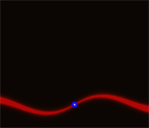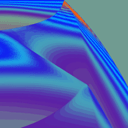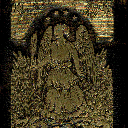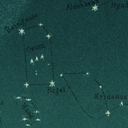|
|
 |
|
|
|
 |
|

|
|
Stars do not go gently: even low-mass stars such as our Sun blow up in the end. Surprisingly, the nebulae resulting from this expulsion phase are rarely spherical. More often they show a pronounced bipolar shape. Balick proposed that such forms arise due to an interaction between a very fast tenuous wind, the `last gasp' of the star, and a disk-shaped denser atmosphere left over from an earlier slow phase of mass loss. Analytical and numerical work shows that this mechanism works very well. However, many circumstellar nebulae have a `multipolar' or `point-symmetric' shape. I demonstrate that these seemingly enigmatic forms can be easily reproduced by a two-wind model in which the confining disk is warped, as is expected to occur in irradiated disks. Large-scale explosions in non-planar disks, such as might occur in active galaxies, are expected to show similar patterns.

This image shows a snapshot from one of my hydrodynamics simulation movies. Colour channels are coded as follows: red is the gas density, green the gas pressure, and blue is the absolute value of the velocity. This image is a logarithmic rendering of the actual flow, in order to improve the dynamic range. Superimposed on the plot is an image of the shape of the original disk, before the wind from the central object blew it up. Note the antisymmetric or `point-symmetric' structure of the resulting nebula: the shape is symmetric under inversion through the central star.

The corresponding movie (10.1 Mb, QuickTime format) has the same colour coding, but in linear instead of logarithmic representation. Notice how the supersonic wind from the central star curves around the inward-pointing edges of the disk, forming a bow shock. One branch of this shock flies off into space, forming a finger-like protrusion. The other branch slams into the concave side of the disk, creating all sorts of complicated shapes. Ultimately, if the disk is not too dense, this shock will break through the disk, producing another finger-like extension.

This type of disk is expected to form when the disk can radiate strongly, and is in its turn irradiated by the light of the central star, as has been shown in the work by Petterson, Iping & Petterson, Pringle, Maloney, Begelman & Pringle, and Livio & Pringle. Most of their papers may be found on the web, for example by way of the Astro-ph archive. The movie above (QuickTime format, 6.3 Mb) shows what such a disk would look like if you were to fly around it.
A colour version of my paper The Riddle of the Red Rectangle, presented at IAU Symposium 209 on Planetary Nebulae, is attached here in PDF format. The published paper will be in black and white.
My contribution to the proceedings of this meeting, which will be published in the ASP Conference Series by Virginia Trimble and Vicent Martinez, can be found here in PDF format.
 |
Bruce Balick, professor of astronomy at the University of Washington in Seattle, will present his spectacular images of the dying star Mz3 in a press release at the Hubble Space Telescope Science Institute and the European Space Agency. Over the years, I have collaborated with Balick and with Garrelt Mellema, doing hydrodynamical computations of the physical mechanisms behind these beautiful outflows. A brief report on my findings, with some computer movie simulations, you will find below. Ultimately, our own Sun will die in a similar event, 5 billion years from now. |
Below I have listed the links to some of my closest colleagues and collaborators. Please check out their websites, if you want to stay informed about what makes science such enormous fun and such a worthy challenge.
![]() Bruce Balick, University
of Washington, Seattle, USA (Planetary nebulae and more)
Bruce Balick, University
of Washington, Seattle, USA (Planetary nebulae and more)
![]() Rien van de Weygaert,
Kapteyn Instituut, Rijksuniversiteit Groningen (Cosmology)
Rien van de Weygaert,
Kapteyn Instituut, Rijksuniversiteit Groningen (Cosmology)
![]() Adam Frank, Rochester University, USA (Astro-hydrodynamics)
Adam Frank, Rochester University, USA (Astro-hydrodynamics)
![]() Ralf Klessen, University of California, Santa Cruz, USA (Star
formation)
Ralf Klessen, University of California, Santa Cruz, USA (Star
formation)
 |
 |
 |
 |
 |

|
One of my main interests is astrophysical hydrodynamics. This branch of theory is similar to the study of the climate and the weather on Earth. The atmosphere of our planet is governed by a large number of interacting processes: heating of the soil, the oceans and the air by the Sun; cooling by radiation; rotation of the planet; evaporation and condensation of water; chemical processes in the atmosphere; and many more. The average effect of all these we call the climate; the actual situation on any given day we call the weather. Likewise, there is a cosmic climate in the Universe, and astronomical weather among the stars. For space is not empty; one cubic centimetre of interstellar space contains, on the average, one gas atom (for comparison: the atmosphere of Earth at sea level is about 10 to the power 21 times more dense, i.e. 1.000.000.000.000.000.000.000 atoms per cubic centimetre).
Just about all matter in the Universe is in the gaseous state. The solidity of Earth is an enormous exception. Thus, hydrodynamics is applicable throughout astrophysics. I study the motion of the gases of stars when they are born in giant clouds of gas that collapse under their own gravity, and when they die in spectacular explosions. Galaxies also form by the gravitational collapse of gas clouds; in the early Universe, the circumstances of galaxy formation are rather different from what we see today.
During a press conference at the Space Telescope Science Institute on December 17th, 1997, Bruce Balick and colleagues reported on some sensational pictures taken with the Hubble Telescope's Wide Field Planetary Camera. These show low-mass stars (like our Sun) in advanced stages of disintegration. The images spectacularly confirm theoretical predictions made nine years ago by myself, Balick, Garrelt Mellema and Adam Frank. A brief explanation of our work in PostScript format provides some background information.
Today (01-02-2001), a new beautiful example of this type of object is being presented by STScI and ESA/ESO.
Two of the most spectacular pictures are those of the bipolar nebula Hubble 5 and the extreme bipolar Minkowski 2-9 . One of my theoretical predictions can be found in another form further down this page. It should be compared with the observations of Minkowski 2-9 . The Space Telescope Science Institute has put together a nice Web page about this subject .
 Structure
of a planetary nebula. In this numerically computed composite
picture (on a logarithmic scale), the red channel indicates the
density, green the pressure, and blue the velocity of the gas.
Structure
of a planetary nebula. In this numerically computed composite
picture (on a logarithmic scale), the red channel indicates the
density, green the pressure, and blue the velocity of the gas.
If you want the lowdown on the analytic backgrounds of my models, you should consult the brief notes on analytic PN hydro in PostScript format I wrote for the occasion. Knowledge of calculus is required!
This is where you'll find all the nice stuff that is about to happen in 5 billion years when our Sun blows up! Check out the hot stuff about planetary nebulae.
 Structure
of a planetary nebula. In this numerically computed composite
picture, the red channel indicates the density, green the temperature,
and blue the velocity of the gas. Notice the formation of a hot
"chimney" in the interior of the nebula.
Structure
of a planetary nebula. In this numerically computed composite
picture, the red channel indicates the density, green the temperature,
and blue the velocity of the gas. Notice the formation of a hot
"chimney" in the interior of the nebula.
Tijdens een persconferentie
aan het Space Telescope Science Institute op 17 december 1997
brachten Bruce Balick en collega's verslag uit van de schitterende
waarnemingen gedaan met de
Hubble Telescope's Wide Field Planetary Camera. Deze tonen sterren
zoals onze Zon die in een vergevorderd stadium van desintegratie
zijn. De beelden, zoals die van de nevel Minkowski
2-9 , zijn een spectaculaire bevestiging van theoretische
voorspellingen die negen jaar geleden zijn gedaan door Vincent
Icke, Balick, Garrelt Mellema en Adam Frank. Op deze Web pagina
vindt u een korte samenvatting
in PostScript formaat van het persbericht, alsmede een langere
versie die u kunt opvragen door hier
te klikken.
Wie wil weten hoe ik nu op het idee kwam om zoiets te doen, en hoe de eerste analytische berekeningen uitpakten, kan meer gegevens vinden in deze korte samenvatting in PostScript formaat. Meer details vindt u in de volgende theoretische beschrijving, eveneens in PostScript, maar daarvoor is elementaire kennis van differentiaalvergelijkingen vereist!
Cosmology is the study of the Universe as a whole. Often, we can take a small component of our Universe - such as a star - and study it separately, pretending that the rest doesn't exist. But stars are born and die in galaxies; these aggregate in clusters, which, in turn, form part of a larger network of matter. At some level, all of these hang together, even down to the elementary particles of which the atoms are made. Therefore, one must at some point confront the interplay of all the components of the Universe together.
I am mostly interested in two aspects of cosmology: the formation of galaxies, and the connection between the structure of space and time on a large scale (the size of galaxies and beyond) and the structure of matter on a small scale (as small as elementary particles). Galaxy formation involves hydrodynamics, star formation, heating and cooling of gas, transport of radiation, and chemical evolution. This stuff I mostly understand, even though getting the `whole orchestra' to play is a formidable task. About the connection between the structure of matter and the structure of space-time I know nothing at all, but that merely says that it's worth a try.
When an infinite gaseous medium collapses under its own gravity, the regions that happen to be a little less dense than average contract a little faster that the Universe expands. The regions that are less dense than average expand somewhat faster than the rest of the Universe. Thus, matter flows away from the low-density regions and towards the zones of higher density. In a paper in 1984, I proved that this means that the low-density regions become more and more spherical, even as they occupy more and more volume. Together with my colleague Rien van de Weygaert, we proved that this implies that self-gravitating matter assumes a very special mathematical form: a Voronoi tessellation.
 Microwave
background image of a Voronoi-cell model
Microwave
background image of a Voronoi-cell model
This is an image of the cosmic microwave background distortions in a Voronoi model universe. White is hot, black is cool. The amplitude is about 1:5000, the image size is about one degree. The maps of the CMBR made with COBE, which you'll find on the COBE home page, have a much smaller amplitude, of about 1:100,000 on a scale of 7 degrees. Averaging a grid of 7x7 Voronoi frames gives a similar amplitude. Higher resolution computations give a more detailed picture, and different colour coding shows extra details in high and low: cool is blue, hot is red.
Besides all this hydro stuff I am also working on the problem of the cosmological constant, or, in other words, on the problem: Why doesn't space weigh anything? In the following PostScript file you'll find my review of the conflict caused by vacuum fluctuations in the Einstein Equation..